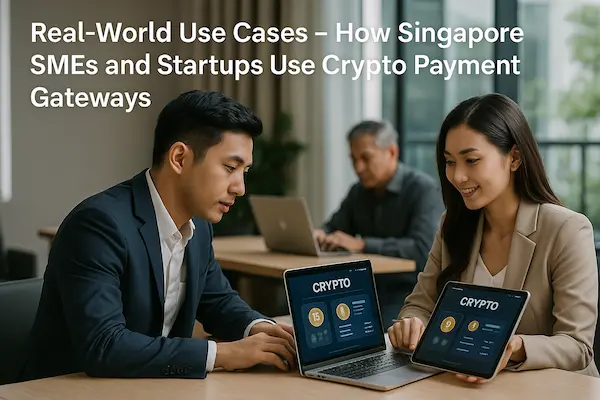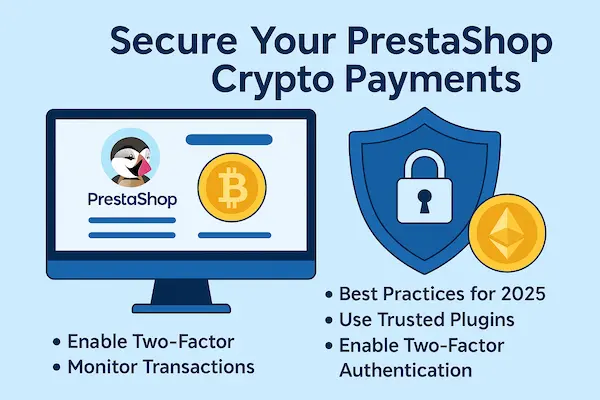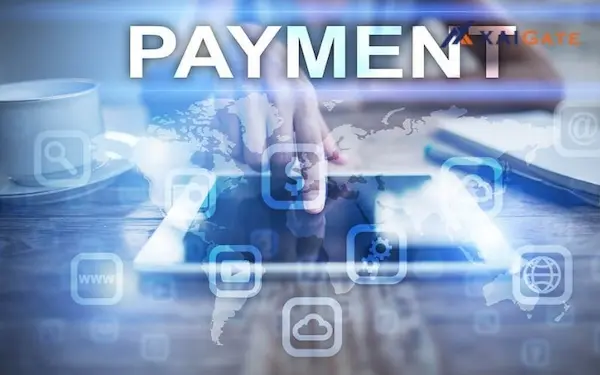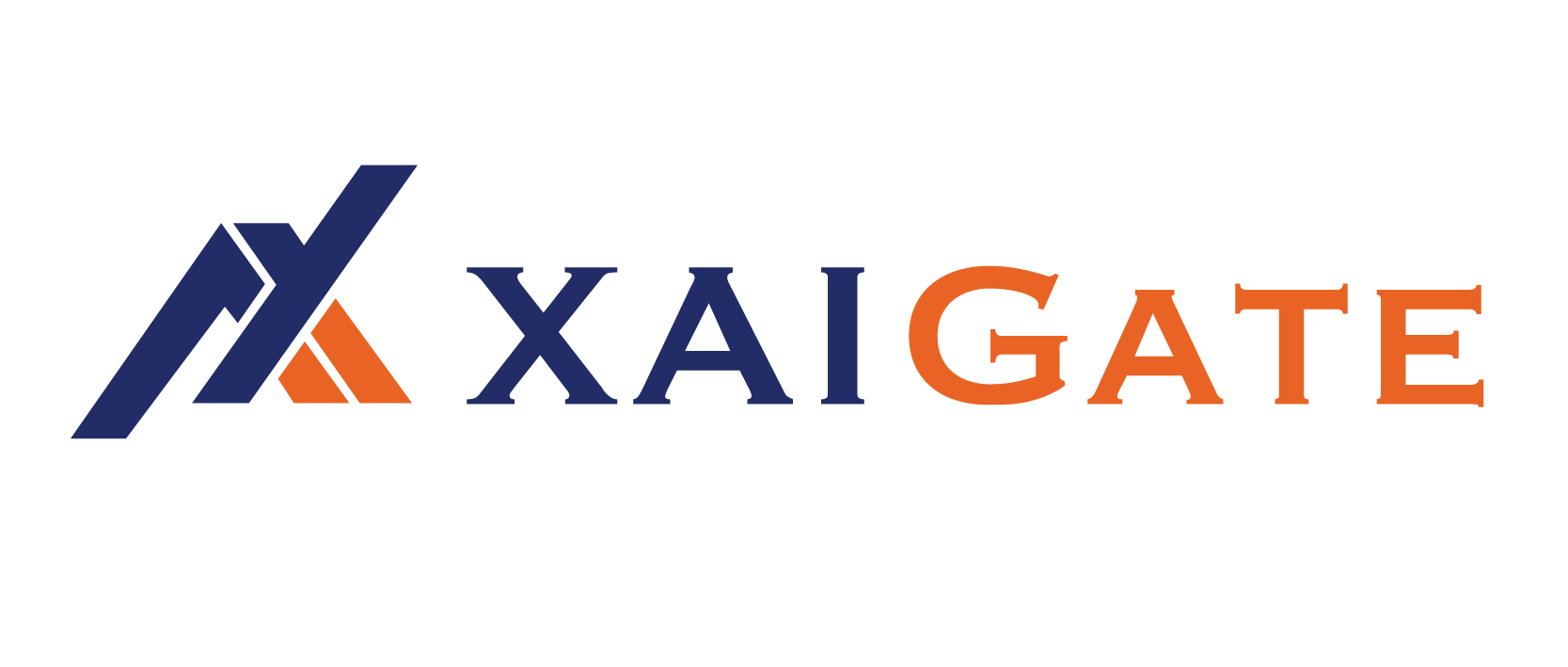Singapore’s SMEs and startups are global from day one: a small B2B SaaS in Singapore can bill clients in the US and Europe, while a D2C brand ships to buyers who live inside wallets and super apps. Traditional rails like cards, bank transfers and platform payouts still work, but they bring high fees, slow settlement and dependence on intermediaries. In this context, Crypto Payment Gateway Singapore SMEs Startups solutions are moving from “Web3 experiments” to practical payment infrastructure, letting customers pay in BTC, ETH or stablecoins while the business still receives SGD or stablecoins in a way that fits MAS and Payment Services Act expectations.
Contents
- 1 1. How Crypto Payment Gateway Singapore SMEs Startups Works in 2026
- 2 2. Why Crypto Payment Gateways Matter for Singapore SMEs and Startups in 2026
- 3 3. What Is a Crypto Payment Gateway in the SME and Startup Context?
- 4 4. Regulatory Basics – PSA, DPT Rules and What Singapore SMEs Must Know
- 5 5. Key Benefits of Crypto Payment Gateways for Singapore SMEs and Startups
- 6 6. Real-World Use Cases: How Singapore SMEs and Startups Use Crypto Payment Gateways
- 7 7. Implementation Guide – How Singapore SMEs and Startups Can Get Started in 2026
- 8 8. Risks, Limitations and How SMEs Can Manage Them
- 9 9. Future of Crypto Payments for Singapore SMEs and Startups
- 10 FAQs – Crypto Payment Gateway Singapore SMEs Startups
- 11 Conclusion and Action Checklist – Turning Crypto Payment Gateway Singapore SMEs Startups into Real Growth
1. How Crypto Payment Gateway Singapore SMEs Startups Works in 2026
1. What is Crypto Payment Gateway Singapore SMEs Startups in practice?
A Crypto Payment Gateway Singapore SMEs Startups setup is essentially a bridge between a customer’s crypto wallet and the SME’s bank account or corporate wallet. The customer pays in digital assets, for example BTC, ETH or stablecoins. The gateway checks the transaction on-chain, handles conversion and then pays out an agreed amount to the business in SGD or in selected stablecoins, on a clear settlement schedule.
From the founder’s point of view, it behaves much like a modern online payment provider. There is a dashboard, transaction history, payout reports and sometimes basic refund tools. The difference is that the gateway understands blockchain networks, wallet addresses and stablecoins, so the team does not need to become crypto experts to get paid. In other words, Crypto Payment Gateway Singapore SMEs Startups lets a company accept crypto as just one more payment rail alongside cards and bank transfers.
2. Key points founders and SME owners should know
In a typical Crypto Payment Gateway Singapore SMEs Startups model:
- Customers can pay from anywhere using BTC, ETH or major stablecoins such as USDT or USDC.
- The gateway operates within Singapore’s Payment Services Act framework, with KYC/AML checks that match the risk level of each transaction.
- The SME or startup chooses how to receive funds: SGD to a local bank account, or stablecoins to a corporate wallet.
- Finance teams get exportable reports in SGD terms, which makes it easier to work with accountants and IRAS.
Used well, Crypto Payment Gateway Singapore SMEs Startups solutions do not replace existing payment methods. Instead, they add a faster, more flexible option for global customers, while helping small businesses improve cash flow and reduce friction in cross-border sales.

2. Why Crypto Payment Gateways Matter for Singapore SMEs and Startups in 2026
For lean teams, every extra fee, blocked payment or slow payout hits runway directly. A well-designed Crypto Payment Gateway Singapore SMEs Startups setup offers one more payment rail that can bring money in faster, with fewer intermediaries and clearer costs.
1. Global Customers and Cross-Border Reality for SMEs
Most Singapore SMEs and startups sell beyond the local market through e-commerce, SaaS or services. Clients in the US, Europe or emerging markets often face failed card attempts, expensive wires and long delays. This makes revenue unpredictable and planning harder for small teams.
2. Pain Points with Cards, Bank Transfers and Platforms
Cards, bank transfers and platform payouts come with high international fees, FX spreads and frequent settlement delays. Marketplaces and app stores may hold funds for weeks and take a large commission. Finance teams then spend time reconciling partial payouts and different currencies instead of focusing on growth.
3. How a Crypto Payment Gateway Changes the Equation
A crypto payment gateway uses blockchain rails and stablecoins so customers can pay from wallets they already use. The gateway confirms the transaction, converts where needed and pays out to the business in SGD or stablecoins on a clear schedule. This can reduce chargebacks, smooth cash flow and unlock a growing base of crypto-native customers without forcing SMEs to manage wallets themselves.
Table 1: Traditional Payments vs Crypto Payment Gateway Singapore SMEs Startups
| Aspect | Traditional Payments (Cards / Bank Transfers / Platforms) | Crypto Payments via Gateway for Singapore SMEs and Startups |
|---|---|---|
| Cross-border fees | High card fees, FX spreads, platform commissions | Clearer, often more transparent pricing for international and high-value payments |
| Settlement speed | Days or weeks for some platforms and international transfers | On-chain confirmation in minutes, with faster payout cycles from the gateway |
| Chargebacks and disputes | Chargebacks can appear weeks after delivery or service | On-chain transactions are final; refunds stay under business control |
| FX and currency management | Multiple currencies to reconcile, complex statements | Customer pays in crypto; business chooses SGD or stablecoin payout |
| Cash-flow visibility | Uncertain timing of inflows, harder runway planning | More predictable inflows and clearer settlement windows |
| Customer experience | Card declines, bank delays, friction for global and crypto-native users | Borderless payments from familiar wallets, simple QR or link flows |
| Operational workload | Heavy manual reconciliation and dispute handling | Streamlined reporting from the crypto payment gateway dashboard and exports |

3. What Is a Crypto Payment Gateway in the SME and Startup Context?
For founders, a Crypto Payment Gateway Singapore SMEs Startups setup is simply a payment layer. It lets customers pay in crypto, while the business still sees clean payouts and reports in SGD or stablecoins, without running an exchange or holding private keys.
1. Simple Definition for Founders and SME Owners
A crypto payment gateway sits between the customer’s wallet and your bank account or corporate wallet:
- Customer pays in BTC, ETH or stablecoins.
- The gateway verifies the on-chain transaction and converts if needed.
- Your business receives SGD or stablecoins on a clear payout schedule.
To your team, it behaves like a modern card processor with a dashboard, history and exportable reports.
2. On-Ramp, Off-Ramp and Stablecoins
Key ideas:
- On-ramp – how customers move fiat into crypto before paying you.
- Off-ramp – how the gateway turns crypto into SGD or stablecoins for your business.
- Stablecoins – tokens like USDT or USDC that track fiat and reduce volatility.
Most setups let customers pay in various coins but quickly convert to stablecoins or SGD so your pricing and treasury stay predictable.
3. How Crypto Payment Gateways Plug into Checkout, Invoicing and Billing
A good gateway connects to tools you already use:
- Extra payment option in e-commerce checkout.
- Payment links or QR codes on B2B invoices.
- API integration for SaaS and subscription billing.
Your store, CRM or billing system just sees a confirmed payment, with crypto treated as one more rail alongside cards and bank transfers.

4. Regulatory Basics – PSA, DPT Rules and What Singapore SMEs Must Know
When you add a Crypto Payment Gateway Singapore SMEs Startups setup, you join a regulated payment chain. You don’t need to be a lawyer, but you do need a basic handle on MAS rules, the Payment Services Act and Digital Payment Tokens.
1. MAS, the Payment Services Act and Digital Payment Tokens
MAS enforces the Payment Services Act (PSA), which includes Digital Payment Token (DPT) services. Most crypto payment gateways for merchants in Singapore fall somewhere inside this framework, usually as licensed or clearly classified DPT/payment service providers. SMEs should only work with gateways that are open about this status.
2. Do SMEs and Startups Need a Licence to Use a Crypto Payment Gateway?
In normal setups, the gateway is the regulated provider and the SME or startup is simply a merchant. You usually do not need your own PSA licence just to accept crypto via a gateway. If you plan to hold customer assets or offer wallet-like services, get professional legal or compliance advice.
3. Tax, Accounting and IRAS – Recording Crypto Sales Properly
Crypto payments still count as regular revenue. Make sure you:
- Capture a clear SGD value at the time of each sale.
- Keep gateway records (amount, rate, timestamp, reference).
- Agree on treatment with your accountants and IRAS early.
A good gateway will give you exportable reports with both crypto amounts and SGD equivalents.
4. Choosing a Compliant Crypto Payment Gateway Singapore SMEs Startups Can Trust
When comparing providers, look past coin lists and fees. Focus on regulatory status, KYC/AML standards, security, reporting and support for small teams. The checklist below summarises what to review before you commit to any Crypto Payment Gateway Singapore SMEs Startups integration.
Table 2: Compliance Checklist for Crypto Payment Gateway Singapore SMEs Startups
| Criterion | What to Look For | Why It Matters |
|---|---|---|
| PSA / DPT status | Licence, exemption or clear written classification | Confirms fit with Singapore rules |
| KYC and AML approach | Documented policies, risk-based checks | Lowers exposure to illicit funds |
| Settlement and payout options | SGD payouts, stablecoins, clear settlement timelines | Supports runway and cash-flow planning |
| Reporting and audit trails | Exportable reports with SGD equivalents and references | Simplifies accounting and IRAS filings |
| Data protection and security | Encryption, access control, incident response | Protects customer data and reputation |
| Contract terms and liability | Clear SLAs, caps, dispute resolution | Clarifies responsibilities in incidents |
| Local and sector experience | Track record with Singapore SMEs or startups | Increases chance of a realistic setup |
| Training and support | Onboarding guides, responsive human support, basic docs | Helps a small team run the gateway daily |

5. Key Benefits of Crypto Payment Gateways for Singapore SMEs and Startups
A well-chosen Crypto Payment Gateway Singapore SMEs Startups setup is not just “another way to get paid”. It can change who you reach, how fast money arrives and how much you keep after fees, all of which matter a lot more when your team and runway are small.
1. Reaching Global Customers with Less Friction
With a crypto payment gateway, customers in the US, Europe or emerging markets can pay from wallets they already use instead of fighting with cards or expensive wires. That reduces checkout friction, especially for high-value B2B invoices or digital products, and makes it easier for SMEs and startups to say “yes” to new markets without rebuilding their whole payment stack.
2. Faster Settlement and Stronger Cash Flow
For young companies, waiting days or weeks for platform payouts or international transfers can be painful. Crypto payment gateways usually confirm transactions within minutes and can offer faster, more predictable payout cycles. That gives founders a clearer view of inflows, which helps with runway planning, payroll, ad spend and inventory decisions.
3. Lower Fees and Better Unit Economics
International card fees, FX spreads and platform commissions quietly eat into margins, especially for large B2B deals or recurring contracts. In many cases, crypto payment gateways offer simpler, more transparent pricing for cross-border flows. Even a small percentage improvement can add up over a year for an SME or startup working with tight unit economics.
4. Brand Positioning with Innovation-Driven Customers
Being early to adopt Crypto Payment Gateway Singapore SMEs Startups solutions also sends a message. It signals to tech-savvy and Web3-aware customers that your company is comfortable with new payment rails and global business. That can help you stand out in crowded verticals, win certain types of clients and create stories that resonate in investor updates and marketing materials.

6. Real-World Use Cases: How Singapore SMEs and Startups Use Crypto Payment Gateways
In practice, a Crypto Payment Gateway Singapore SMEs Startups setup shows up in very simple places: checkout pages, invoices, subscription flows and payment links. The goal is not to replace all existing methods, but to add one flexible rail that works especially well for global and crypto-native customers.
1. E-commerce and D2C Brands Selling to Global Crypto Users
Singapore D2C and e-commerce brands can add a crypto option alongside cards at checkout. Customers choose products as usual and then pay from a wallet via QR code or a simple payment button. This reduces friction for overseas buyers who prefer crypto and helps the brand own the relationship instead of relying only on marketplaces.
2. B2B SaaS, Agencies and Freelancers Billing in Crypto and Stablecoins
B2B SaaS companies, agencies and freelancers can issue invoices with a crypto payment link attached. Clients settle retainers, project fees or subscriptions in BTC, ETH or stablecoins, while the business receives SGD or stablecoins through the gateway. This is particularly useful for high-ticket B2B deals where card limits and bank processes often slow things down.
3. Web3, GameFi and Digital Creators Monetising On-Chain Communities
Web3 startups, GameFi studios and digital creators already have communities that live on-chain. They can route NFT sales, in-game items, memberships or donations through a crypto payment gateway so that value from different chains eventually lands in a single, structured payout flow. This keeps on-chain flexibility for users but gives the team clearer reporting and treasury control.
4. Non-Profits and Social Enterprises Accepting Crypto Donations
Some non-profits and social enterprises in Singapore are beginning to accept crypto donations from supporters overseas. A gateway lets them publish a simple payment link or QR code, receive funds in crypto and then convert to SGD or stablecoins for operational use. Donors get a straightforward way to give, while the organisation benefits from transparent records it can share with auditors and stakeholders.

7. Implementation Guide – How Singapore SMEs and Startups Can Get Started in 2026
Rolling out a Crypto Payment Gateway Singapore SMEs Startups setup is mainly about a few clear decisions and a small, focused rollout. You don’t need a big IT team, just a simple plan.
1. Define Use Cases, Ticket Sizes and Target Customers
Decide where crypto fits first: website checkout, B2B invoices, high-value projects, donations or memberships. Note your usual deal sizes, key markets and which offers you will include in the pilot.
2. Select a Compliant Crypto Payment Gateway for Singapore SMEs Startups
Shortlist gateways that are transparent about PSA/DPT status, support the coins your customers use, offer SGD or stablecoin payouts and have reporting that suits small teams. Pick the option that balances compliance, reliability and ease of use, not just the longest coin list.
3. Integrate with Storefronts, Billing and Accounting
Add the gateway as an extra payment method in your e-commerce, billing or invoicing tools. For B2B, start with simple payment links or QR codes. Make sure each transaction has a clean reference that your accounting software can match.
4. Set Internal Policies and Train a Small Owner Team
Write a short policy: which coins you accept, auto-convert rules, limits and who can access the dashboard. Train 1–2 people (usually a founder and someone in finance) to manage payouts, refunds and basic support.
5. Pilot First, Then Scale
Run a narrow pilot with one product line, region or client segment. Track transaction numbers, values, fees, settlement speed and issues. When the process feels stable, extend the Crypto Payment Gateway Singapore SMEs Startups setup to more products and channels as part of your normal payment mix.
8. Risks, Limitations and How SMEs Can Manage Them
Even with clear benefits, a Crypto Payment Gateway Singapore SMEs Startups setup is not risk-free. Most issues can be managed, but only if founders, finance and ops understand where things can go wrong and put a few safeguards in place.
1. Volatility, Stablecoins and Treasury Management
If you accept volatile coins, the value can move between payment and payout. The simplest way to reduce this is to:
- Focus on trusted stablecoins (USDT, USDC or similar).
- Use auto-conversion to SGD or stablecoins where possible.
- Decide clearly what you will hold, and for how long.
This keeps pricing and runway planning more predictable.
2. Operational Errors and Customer Support Issues
Crypto payments are sensitive to details: wrong address, wrong network or wrong amount can break a transaction. To reduce issues:
- Standardise workflows for generating payment links and QR codes.
- Limit dashboard access to trained staff.
- Prepare simple support scripts to help customers retry failed payments.
3. Compliance, Fraud and Dispute Handling
Even without card-style chargebacks, you still have to handle fraud attempts, disputes and refund requests. Choose a gateway with clear KYC/AML standards, logging and refund tools. Internally, decide who approves refunds and how you document them so audits and investor reviews are straightforward.
4. Best Practices for a Low-Risk Crypto Payment Gateway Singapore SMEs Startups Strategy
Start small, document basic rules and review them after your first wave of transactions. Make sure at least one founder and one finance owner actively monitor reports and settlement patterns. Treated this way, a Crypto Payment Gateway Singapore SMEs Startups setup can stay low-risk, explainable and aligned with how your business already manages money.
9. Future of Crypto Payments for Singapore SMEs and Startups
Over the next few years, crypto is likely to feel less like a niche and more like another layer in everyday business tools. For many teams, a Crypto Payment Gateway Singapore SMEs Startups setup will sit quietly behind checkouts, invoices and platforms, while customers just see faster, more flexible ways to pay.
1. Embedded Finance, Super Apps and SME Platforms
More SME tools and marketplaces are adding “embedded payments” directly into their workflows. As wallets and super apps integrate crypto rails, gateways that already support Singapore SMEs will be in a good position to plug in. This can make accepting global, on-chain payments feel as simple as switching on a new toggle in an existing platform.
2. Tokenised Invoices, On-Chain Financing and SME Credit
Tokenised invoices, revenue-share contracts and on-chain financing are emerging as new ways for small businesses to access credit. A crypto payment gateway that tracks flows clearly in SGD terms can help SMEs connect sales, payouts and financing in one traceable stream, instead of juggling disconnected systems.
3. Ecosystem Signals and Support for Digital Payments
As regulators, ecosystem players and enterprise partners refine their approach to digital assets, Singapore SMEs and startups will see clearer guidance and better tools. Businesses that already understand how their crypto flows work – and can show clean records from a gateway – will be better placed to join pilots, partnerships or new digital payment programs.
4. How Crypto Payment Gateway Singapore SMEs Startups Could Evolve by 2026 and Beyond
By 2026, many teams may treat Crypto Payment Gateway Singapore SMEs Startups deployments as standard infrastructure, not experiments. Gateways that combine strong compliance with simple integrations and good reporting will likely become long-term partners, helping SMEs and startups use crypto rails when they make sense, without turning payments into a full-time side project.
FAQs – Crypto Payment Gateway Singapore SMEs Startups
1. What is a crypto payment gateway for Singapore SMEs and startups?
It’s a service that lets customers pay in BTC, ETH or stablecoins while your business receives SGD or stablecoins. The gateway verifies the on-chain transaction, converts funds and sends payouts to your account.
2. Do Singapore SMEs need a Payment Services licence to use a crypto payment gateway?
Usually no. The gateway is the regulated payment / DPT provider and your business is just a merchant, unless you start holding customer assets or offering financial services yourself.
3. Which cryptocurrencies and stablecoins are most practical for SMEs and startups?
Stablecoins like USDT and USDC are usually best because they track fiat value. Many SMEs let clients pay in BTC or ETH but ask the gateway to auto-convert to stablecoins or SGD.
4. How do crypto payment gateways integrate with e-commerce and SaaS billing tools?
Most offer plugins, hosted pages or APIs. You add them as an extra payment method in your store or billing tool, and they return a “paid” status once the crypto transaction is confirmed.
5. How are crypto payments treated for tax and accounting in Singapore?
They are treated as normal business revenue. You need a reliable SGD value at the time of sale and clear gateway reports to support accounting and IRAS filings.
6. What are the main risks of using a crypto payment gateway for SMEs and startups?
Key risks are volatility, operational mistakes with addresses or networks, and poor reporting. Focusing on stablecoins, using a compliant gateway and having simple internal processes helps reduce them.
7. Can non-technical SMEs adopt crypto payments without a dedicated IT team?
Yes. Many small teams start with plugins, hosted checkout pages or payment links that require little or no custom code, plus one person owning payouts and reconciliation.
8. How should founders choose a crypto payment gateway Singapore SMEs Startups can trust?
Look for clear PSA/DPT status, SGD or stablecoin payouts, solid KYC/AML, good reporting and responsive support. A good partner can explain its model in plain language and show similar SME clients.
Conclusion and Action Checklist – Turning Crypto Payment Gateway Singapore SMEs Startups into Real Growth
A well-planned Crypto Payment Gateway Singapore SMEs Startups setup is less about hype and more about practical gains: smoother global payments, better cash flow and a clearer story for investors and partners. The key is to treat it as part of your payment and finance strategy, not as a side experiment.
Why Crypto Payment Gateways Matter
For Singapore SMEs and startups, crypto payment gateways can:
- Reduce friction for global and crypto-native customers.
- Improve settlement speed and cash-flow visibility.
- Cut some cross-border and platform-related fees.
- Strengthen brand positioning with innovation-driven clients and investors.
Action Checklist for Founders and SME Owners
You can start small with these five steps:
- Define your use cases – checkout, invoices, high-value projects, donations.
- Pick a compliant gateway – clear PSA/DPT status, SGD or stablecoin payouts.
- Integrate lightly – plugins, hosted pages or payment links tied to your current tools.
- Set internal rules – coins accepted, auto-conversion, limits, dashboard access.
- Run a pilot and review – track usage, fees, settlement speed and any issues, then scale what works.
Table 3: Rollout Plan and ROI Snapshot for Crypto Payment Gateway Singapore SMEs Startups
| Step | Typical Timeframe | Main Owner in SME / Startup | Key Outcome / ROI Signal |
|---|---|---|---|
| Define use cases & policy | 1–2 weeks | Founder / Finance / Ops | Clear scope for where crypto will be used |
| Select gateway partner | 2–4 weeks | Founder / Finance / Legal | Compliant provider aligned with PSA / DPT expectations |
| Basic integration & testing | 2–6 weeks (pilot scope) | Tech lead / Vendor / Gateway | Working crypto option for selected products or clients |
| Staff onboarding & guidelines | 1–2 weeks | Founder / Finance / Ops | Team knows how to handle payments, payouts and refunds |
| Pilot and review | 1–3 months | Founder / Finance | Data on usage, fees, settlement speed and customer feedback |
| Scale and optimise | Ongoing | Management team | Crypto becomes a stable, low-friction part of the payment mix |
For daily updates, subscribe to XAIGATE’s blog!
We may also be found on GitHub, and X (@mxaigate)!










